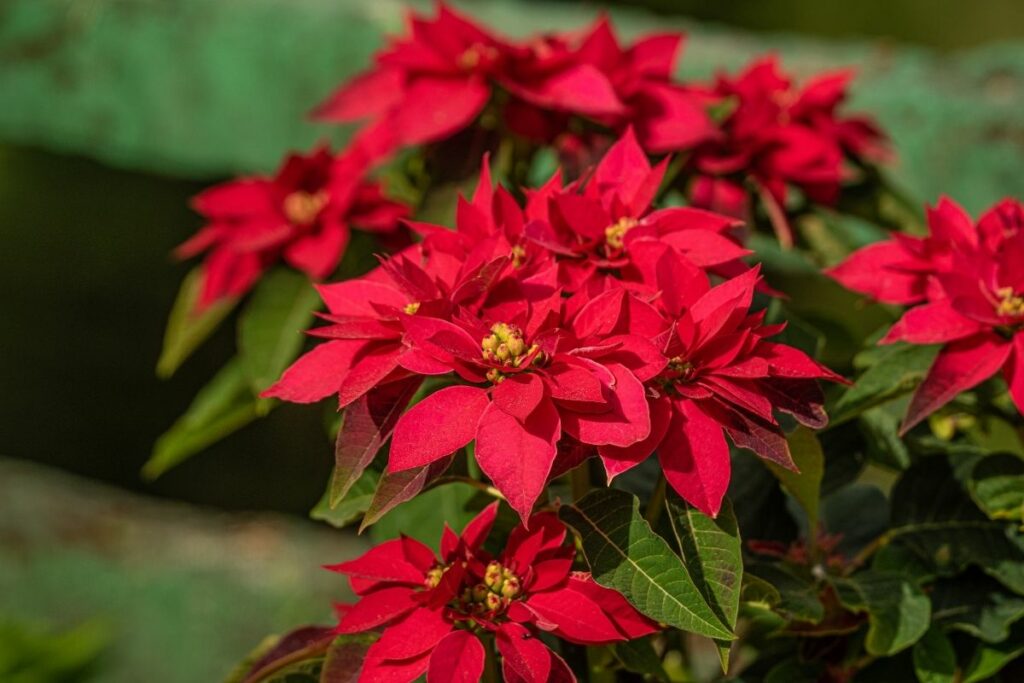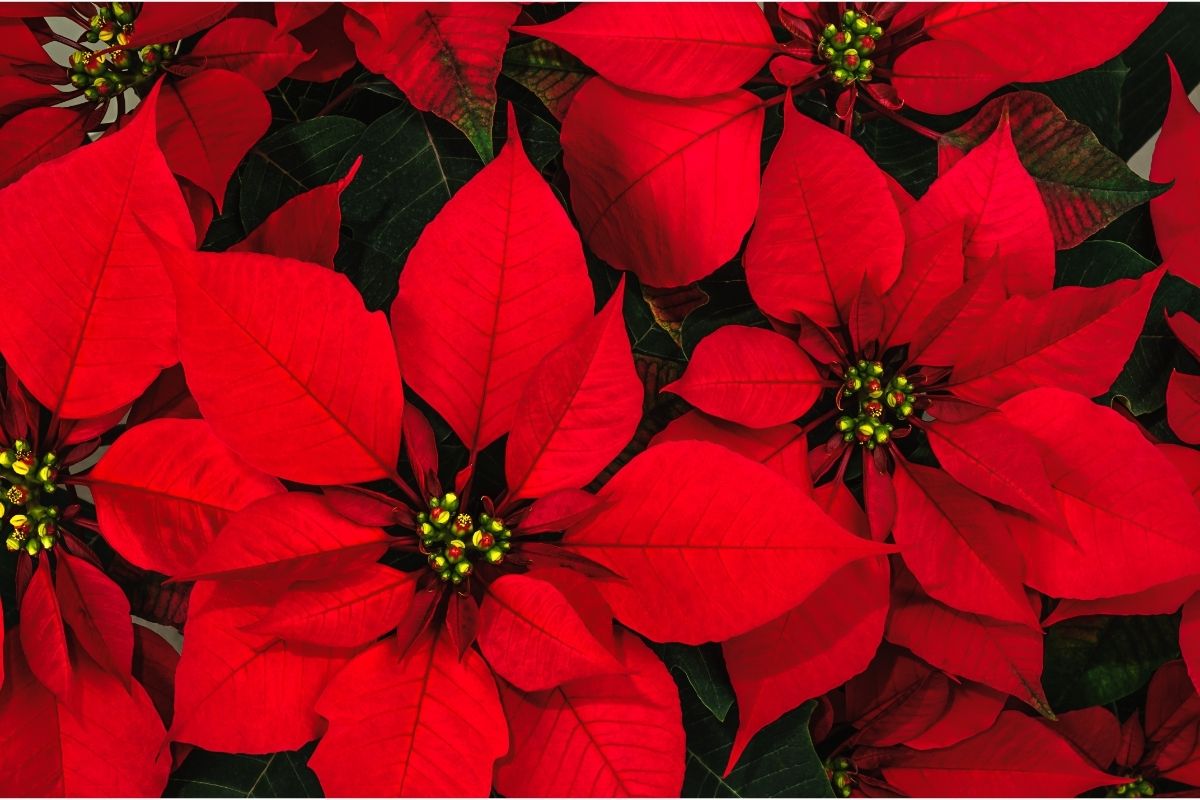
The poinsettia plant is the image of Christmas for many people throughout the world. Its deep red flowers and striking green leaves create a stunning visual that is guaranteed to brighten up any room.
But how can you keep your poinsettia looking its best? Keep reading to find out how to properly prune your poinsettia plant and some other quick tips to keep it super healthy.
What Are Poinsettias?
The poinsettia is part of the Euphorbiaceae family. They are native to Mexico and surrounding Central America and were first cultivated by the Aztecs.
Today, they are perhaps the most important plant for economic purposes – over 70 million are sold in the US in just six weeks.
They are by far at their most popular at Christmas time, but with just a few small adjustments they can look beautiful all year round.
All you need to do is regulate their water intake and soil conditions, as well as give them a little prune.
How To Prune Poinsettia

Before you begin pruning, we recommend that those with delicate or sensitive skin put on a pair of gloves.
Poinsettias are not toxic but their sap can irritate. If you come into contact with the sap, don’t panic and simply wash the area with soap and water.
February And March
It is best to prune your poinsettia after they have finished blooming and after the coldest time of year has passed. For most poinsettias, this will be sometime in February or March.
Begin by trimming off any dry, limp, or discolored leaves. Do this by cutting at a 45° angle in the stem just below the leaf.
It is natural for some petals or leaves to fall off while you work but try not to cut off any unnecessary foliage. Any leaves that are vibrant green should be avoided.
Prune until you have removed all of the damaged leaves. Keep in mind that you should not prune more than 30% of your poinsettia. This will be too traumatizing for the plant and it may not recover.
Prune down the stems so that they are no more than 6 inches in length (around 15cm). Poinsettias can grow to be fairly large shrubs if left alone, hence the importance of this initial trim.
We recommend that you trim the stems after you have removed dying leaves as it is easier to see what you are doing and you can work more accurately.
Keep in mind that this is just a guide. If you prefer larger, more substantial plants or would like a striking poinsettia during the festive season you can leave the stems longer.
Keeping them at around 8 inches (20cm) will not do the poinsettia any harm.
If you so wish, you can use the trimmed stems to propagate new plants. All you need to do is dip the cut end into some rooting hormone and then place this in a pot with compost.
March To November
Prune regularly throughout the next months so that your poinsettia remains a similar size.
We recommend that you check back in once a month to see how your plant is progressing. If it has grown, you can trim the stems back to 6 inches (15cm) or longer if you prefer.
Be sure to leave 3 or 4 new leaves to encourage growth. This will also help keep a pleasant, rounded shape with dense foliage. Prevent bushiness by pinching off small shoots.
September
During this period, you need to find an appropriate cupboard for your poinsettia to move to.
You need to keep your plant in the dark for over 12 hours a day from mid-September onward so that it has plenty of time to develop its characteristic red leaves. This needs to be done for 8 to 10 weeks.
Any dark location will do. Be it in the closet, under a box, or a cover – you just need to make sure that no light can get in.
Outside of this dark time, your plant should be getting some non-direct sunlight. We recommend that you set an alarm so you don’t forget.
November
Your poinsettia will begin to flower and change color as winter develops. By November, you want to stop pruning altogether so your plant looks its best for the festive period.
December To January
During these months you can sit back and enjoy your poinsettia plant. No trimming after November gives your plant lots of time to develop its famed red foliage.
Be sure to keep it in an appropriate environment and keep in mind that it may require more water as its leaves develop.
Quick Pruning Tips
- Be sure to disinfect your shears before you use them. This will prevent the transmission of harmful bacteria from one plant to another.
Poinsettia Toxicity
As with other plants in the Euphorbiaceae family, the poinsettia can ooze a milky sap. This sap is likely to irritate the skin of those with latex allergies after you come into contact with it.
The sap could also cause similar irritation and nausea if ingested. The sap is mostly secreted from the leaves so it may be necessary for you to wear gloves if you are sensitive.
We recommend that you keep pets and small children away from the plant. This will prevent accidental ingestion.
That said, you do not need to be unduly worried. A 50lb child would have to eat over 500 large leaves before any effects are felt.
As they don’t taste very nice, you don’t need to worry! Pets are also unlikely to deliberately eat the leaves for the same reason.
Ideal Poinsettia Growing Conditions
You need to try to create the best possible growing conditions so that your poinsettia can thrive.
Be sure to water your plant regularly and be sure to give it proper drainage. However, do not overwater your plant as you may cause root rot. Only water when the surface of the soil feels dry when you touch it.
Keep your poinsettia in a room that has lots of sun and is at least 55°F (13°C). Try to avoid drafty locations as these will have too much temperature fluctuation throughout the day. Direct sun should also be avoided.
Final Thoughts
Poinsettias are gorgeous plants that reward your hard work with striking red and green foliage at the end of the year.
Prune from February to November, being sure to keep the stems to your preferred length. Be sure to regularly check on your plant and remove excess growth or dying leaves.
Try to avoid cutting off unnecessary parts of your plant and do not prune more than 30% at once.
From November on, do not prune your poinsettia. This will give it plenty of time to develop its famous red foliage.
- Best Hanging Plant For Low Light - September 4, 2023
- Best Indoor Plants Florida - August 28, 2023
- Best Plants For Bathroom Smells - August 21, 2023








